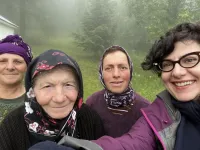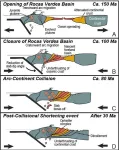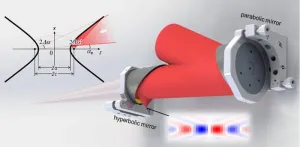(Press-News.org) A new data crowdsourcing platform aims to preserve the sound of Romeyka, an endangered millennia-old variety of Greek. Experts consider the language to be a linguistic goldmine and a living bridge to the ancient world.
The initiative, led by Professor Ioanna Sitaridou from the University of Cambridge, contributes to the UN’s International Decade of Indigenous Languages (2022-32), which aims ‘to draw global attention on the critical situation of many indigenous languages and to mobilise stakeholders and resources for their preservation, revitalization and promotion.’
Romeyka is thought to have only a couple of thousand native speakers left in Turkey’s Trabzon region, but the precise number is hard to calculate especially because of the fact that there is also a large number of heritage speakers in the diaspora and the ongoing language shift to Turkish.
Romeyka does not have a writing system and has been transmitted only orally. Extensive contact with Turkish, the absence of support mechanisms to facilitate intergenerational transmission, socio-cultural stigma, and migration have all taken their toll on Romeyka. A high proportion of native speakers in Trabzon are over 65 years of age and fewer young people are learning the language.
The newly launched trilingual Crowdsourcing Romeyka platform invites members of the public from anywhere in the world to upload audio recordings of Romeyka being spoken.
“Speech crowdsourcing is a new tool which helps speakers build a repository of spoken data for their endangered languages while allowing researchers to document these languages, but also motivating speakers to appreciate their own linguistic heritage. At the same time, by creating a permanent monument of their language, it can help speakers achieve acknowledgement of their identity from people outside of their speech community,” said Prof. Sitaridou, who has been studying Romeyka for the last 16 years.
The innovative tool is designed by a Harvard undergraduate in Computer Science, Mr Matthew Nazari, himself a heritage speaker of Aramaic. Together they hope that this new tool will also pave the way for the production of language materials in a naturalistic learning environment away from the classroom, but based instead around everyday use, orality, and community.
To coincide with the platform’s launch, Sitaridou is unveiling major new findings about the language’s development and grammar at an exhibition in Greece (details below).
Sitaridou’s most important findings include the conclusion that Romeyka descends from Hellenistic Greek not Medieval Greek, making it distinct from other Modern Greek dialects. “Romeyka is a sister, rather than a daughter, of Modern Greek,” said Sitaridou, a Fellow of Queens' College and Professor of Spanish and Historical Linguistics in Cambridge’s Faculty of Modern and Medieval Languages and Linguistics. “Essentially this analysis unsettles the claim that Modern Greek is an isolate language”.
Over the last 150 years, only four fieldworkers have collected data on Romeyka in Trabzon. By engaging with local communities, particularly female speakers, Sitaridou has amassed the largest collection of audio and video data in existence collected monolingually and amounting to more than 29GB of ethically sourced data, and has authored 21 peer-reviewed publications. A YouTube film about Sitaridou’s fieldwork has received 723,000 views to-date.
Grammar and a new phylogeny for Greek
Sitaridou’s analysis of the Romeyka infinitive is key. All other Greek dialects known today have stopped using the infinitive found in ancient Greek. So speakers of Modern Greek would say I want that I go instead of I want to go. But, in Romeyka, the infinitive lives on and Sitaridou has observed uncontroversial proof that this Ancient Greek infinitive can be dated back to Hellenistic Greek due to its preservation in a structure which became obsolete by early Mediaeval times in all other Greek varieties, but continued to be used in Romeyka while also undergoing a cross-linguistically rare mutation to a negative item.
Sitaridou’s findings have significant implications for our understanding of the evolution of Greek, because they suggest that there is more than one Greek language on a par with the Romance languages (which all derived out of Vulgar Latin rather than out of each other).
Historical context and new field work sites
The roots of the Greek presence in the Black Sea are steeped in myth: from the journey of Jason and the Argonauts to Colchis, to the Amazons. But what we know is that the Greeks began to spread around the Black Sea from approximately the 6th Century BCE. Ionians founded Miletus, which, in turn, founded Sinope, which, eventually, colonized Trebizond. In the Pontus, the language of the first Greek colonizers of Trebizond was the Ionic Greek of Sinope.
In the 4th Century BCE, the passage of Alexander the Great’s army contributed to the creation of another Greek-speaking centre, to the South of Pontus, at Cappadocia. It is possible that from Cappadocia, Greek may have also spread northwards towards Pontus.
However, the decisive phase for the expansion of the Greek language seems to be Christianization. The inhabitants of Pontus were among the first converts and are mentioned in the New Testament. The Soumela monastery was founded in 386 CE, around 20 years after the region officially adopted Christianity. The fall of Trebizond to the Ottomans in 1461 led to the city becoming majority Muslim.
Prof. Sitaridou said: “Conversion to Islam across Asia Minor was usually accompanied by a linguistic shift to Turkish, but communities in the valleys retained Romeyka. And because of Islamization, they retained some archaic features while the Greek-speaking communities who remained Christian grew closer to Modern Greek, especially because of extensive schooling in Greek in the 19th and early 20th centuries.”
Recently, Prof. Sitaridou started field working in a new site, Tonya, where no other field worker has ever reached, only to reveal significant grammatical variation between the valleys indicating different Islamisation onset. In a publication, to appear soon, it is argued that both the syntax of subordination and negation systems in Tonya show different patterns and thus diachronic development from the Çaykara variety.
In 1923, under the Greco-Turkish population exchange, Greek-speaking Christians of Pontus were forced to leave Turkey and relocate to Greece while Romeyka-speaking Muslim communities in the Trabzon area remained in their homeland as they professed Islam, explaining why this Greek variety is still spoken in small enclaves in the region. Since 1923 and until very recently the two speech communities were oblivious of each other’s existence.
Preservation of heritage languages and why it matters
Speakers are still reluctant to identify Romeyka as one of their languages since, for Turkish nationalists, speaking Greek goes against the very fundamentals of one’s belonging. From a Greek nationalist perspective, these varieties are deemed ‘contaminated’ and/or disruptive to the ideology of one single Greek language spoken uninterruptedly since antiquity, as Sitaridou explains in an article which is about to be published by the Laz Institute in Istanbul.
In Greece, Turkey and beyond, Sitaridou has used her research to raise awareness of Romeyka, stimulate language preservation efforts and enhance attitudes. In Greece, for instance, Sitaridou co-introduced a pioneering new course on Pontic Greek at the Democritus University of Thrace since the number of speakers of Pontic Greek is also dwindling.
“Raising the status of minority and heritage languages is crucial to social cohesion, not just in this region, but all over the world,” Prof. Sitaridou said. “When speakers can speak their home languages they feel “seen” and thus they feel more connected to the rest of the society; on the other hand, not speaking the heritage or minority languages creates some form of trauma which in fact undermines the integration which linguistic assimilation takes pride in achieving”.
The same ethos traverses a new AHRC-funded project about the documentation of a critically endangered language, Sri Lanka Portuguese, among Afrodescent communities in north-western Sri Lanka. Sitaridou will be documenting and analysing manja, the only remaining linguistic and cultural expression of African heritage for these communities.
Exhibition at Mohamed Ali’s historical House in Kavala this April
The Romeyka exhibition runs at the MOHA Research Centre in Kavala, Greece, from 29th March – 28th April 2024.
The exhibition features previously unpublished archival material from Exeter College, Oxford and photographic material from British School of Athens which give us a glimpse into the Greek-speaking communities and language in the southern Black Sea shores 110 years ago taken by R.M. Dawkins, one of the first field workers in the area. This is combined with photographs and video material from Prof. Sitaridou’s own fieldwork, interspersed with panels and audio material to communicate her linguistic findings.
The exhibition aims to generate further reflections on endangered heritages, fragmented and shared identities and collective memory as well as helping us get a better grasp of multilingualism, localised experiences, intergenerational stories of co-existence and displacement, diasporic selves and language loss, and alternative modalities of being and belonging both in Greece and Turkey.
Media contacts
Tom Almeroth-Williams, Communications Manager (Research), University of Cambridge: researchcommunications@admin.cam.ac.uk / tel: +44 (0) 7540 139 444
Professor Ioanna Sitaridou, University of Cambridge and Queens’ College: is269@cam.ac.uk
END
Last chance to record archaic Greek language ‘heading for extinction’
2024-04-03
ELSE PRESS RELEASES FROM THIS DATE:
Chicks prove vision and touch linked at birth
2024-04-03
Newly hatched chicks raised in darkness and allowed to touch either a smooth or bumpy cube for 24 hours instantly recognised the object with their vision upon first exposure to light.
This suggests chicks can link touch and vision without any prior experience combining these senses, challenging the long-held belief that such integration requires learning.
The discovery implies a pre-wired ability in the brain for cross-modal perception, potentially redefining our understanding of animal cognition and sensory processing.
In a study published in Biology Letters, researchers at Queen Mary University of London have cracked ...
Researchers propose new step in tectonic squeeze that turns seafloor into mountains
2024-04-03
Scientists use tiny minerals called zircons as geologic timekeepers. Often no bigger than a grain of sand, these crystals record chemical signatures of the geological environment where they formed. In a new study led by scientists at The University of Texas at Austin, researchers used them to describe what could be an overlooked step in a fundamental tectonic process that raises seafloors into mountains.
In a study published in the journal Geology, the researchers describe zircons from the Andes mountains of Patagonia. Although the zircons formed when tectonic plates were colliding, they have a chemical signature associated ...
Gut bacteria that strongly influence obesity are different in men and women, study finds
2024-04-03
Novel approach finds gut microbiota that are highly predictive of BMI, waist circumference, and fat mass are different in men and women
And might change the chemical makeup (metabolome) of the gut in ways that affect the metabolism of different bioactive molecules that influence metabolic disease development
Interventions to help prevent obesity-favourable microbiome may need to be different in men and women
*This is an early press release from the European Congress on Obesity (ECO 2024) Venice 12-15 May. Please credit the Congress if using this material*
New research being presented at this year’s European ...
Double trouble: the risks of mixing alcohol and sports wagering
2024-04-02
It turns out that money isn’t the only thing sports gamblers are risking. According to a new study, bettors who wager on sporting events, esports, and daily fantasy sports are much more likely than other individuals to binge drink.
The findings, compiled by a research team from UNLV and the University of New Mexico, were published this week in the journal JAMA Network Open.
Over the course of three weeks in spring 2022, researchers surveyed more than 4,300 adults across the U.S. Nearly 3,300 self-reported past year alcohol use, while about 1,800 identified themselves as gamblers who had bet on sports in the past year.
Researchers ...
Far-UVC light can virtually eliminate airborne virus in an occupied room
2024-04-02
NEW YORK, NY--Far-UVC light is a promising new technology for reducing airborne virus levels in occupied indoor spaces, but its effectiveness has not been evaluated in real-life scenarios.
A new study by Columbia researchers now shows that far-UVC light inactivated nearly all (>99%) of an airborne virus in an occupied work environment, showing that the technology can work as well in a real-life scenario as in the laboratory.
“The results show that far-UVC is highly effective at reducing airborne pathogens in an ordinary occupied room, and so it’s practical to use far-UVC light in indoor areas where people are going about their business,” says David ...
A new estimate of U.S. soil organic carbon to improve Earth system models
2024-04-02
Soil contains about twice as much carbon as the atmosphere and plants combined. It is a major carbon sink, capable of absorbing more carbon dioxide from the atmosphere than it releases. Management of soil carbon is key in efforts to mitigate climate change, in addition to being vital to soil health and agricultural productivity.
Measuring soil carbon, however, is a painstaking, expensive process. Samples must be dug from the ground and sent to a lab for analysis, making upscaling measurements on a large spatial scale ...
Scientists’ urgent call: end destruction and forge a just, sustainable future
2024-04-02
An international team of scientists published a study today in the Proceedings of the National Academy of Sciences NEXUS emphasizing the urgent need to align political will, economic resources, and societal values to ensure a more sustainable and equitable world. Led by University of Hawai‘i at Mānoa researchers, the 18 authors combine their expertise in earth and ocean sciences, politics, law, public health, renewable energy, geography, communications, and ethnic studies to assess causes, impacts, and solutions to a multitude of worldwide crises.
“Climate change, ecological destruction, disease, pollution, and socio-economic inequality ...
First results from BREAD experiment demonstrate a new approach to searching for dark matter
2024-04-02
One of the great mysteries of modern science is dark matter. We know dark matter exists thanks to its effects on other objects in the cosmos, but we have never been able to directly see it. And it’s no minor thing—currently, scientists think it makes up about 85% of all the mass in the universe.
A new experiment by a collaboration led by the University of Chicago and Fermi National Accelerator Laboratory, known as the Broadband Reflector Experiment for Axion Detection or BREAD, has released its first results in the search for dark matter in a ...
Focusing ultra-intense lasers to a single wavelength
2024-04-02
Ultra-intense ultrashort lasers are powerful tools used in various fields like physics, national security, industry, and healthcare. They help researchers delve into strong-field laser physics, laser-driven radiation sources, particle acceleration, and more.
“Peak power” measures the intensity of these lasers, like the Nova laser (Lawrence Livermore National Laboratory, California, USA) with 1.5 petawatts of peak power, the Shanghai Super-intense Ultrafast Laser Facility (SULF, China) with 10 petawatts, or the Extreme Light Infrastructure – Nuclear Physics (ELI-NP, Romania) with a peak ...
Combining food taxes and subsidies can lead to healthier grocery purchases for low-income households
2024-04-02
Chapel Hill, NC, April 2, 2024 — A new study that models the combined effects of a sugar-based tax on beverages and targeted subsidies for minimally processed foods and drinks found that under these policies, low-income consumers would purchase less sugar-sweetened beverages and more fruits, vegetables, and healthier drinks, particularly in households without children.
Researchers at the University of North Carolina at Chapel Hill developed a model to simulate what would happen if national-level taxes on less-healthy, ...





